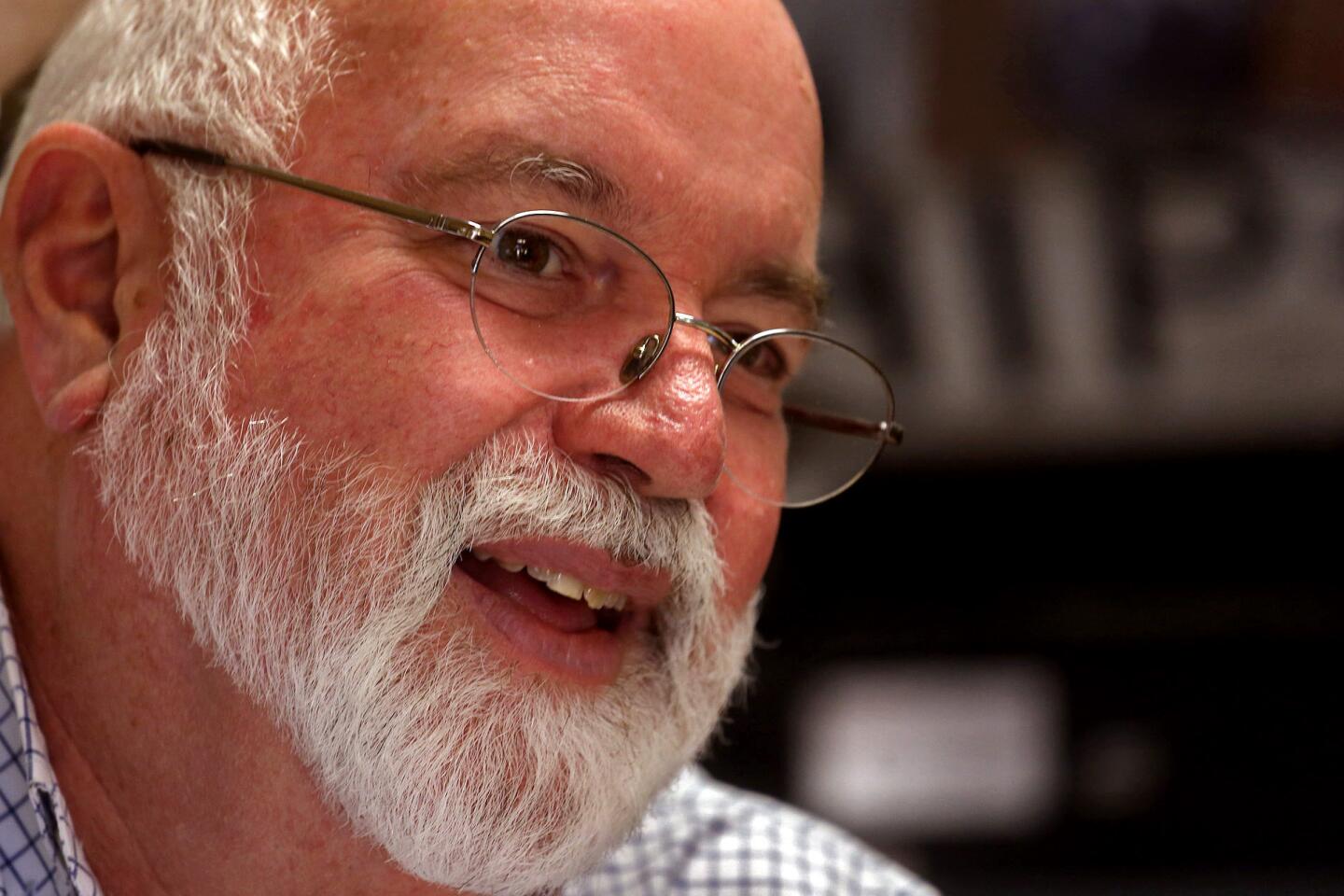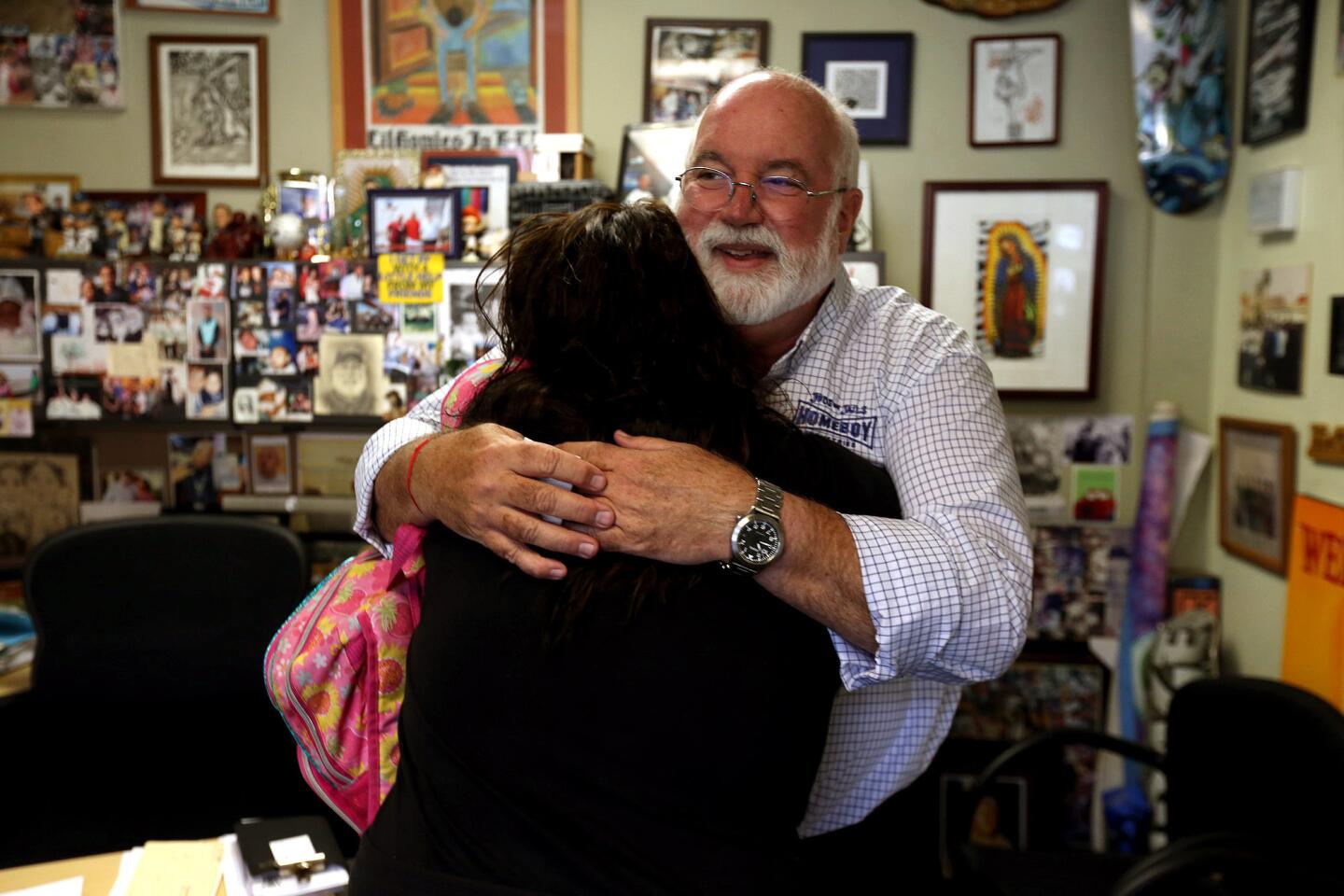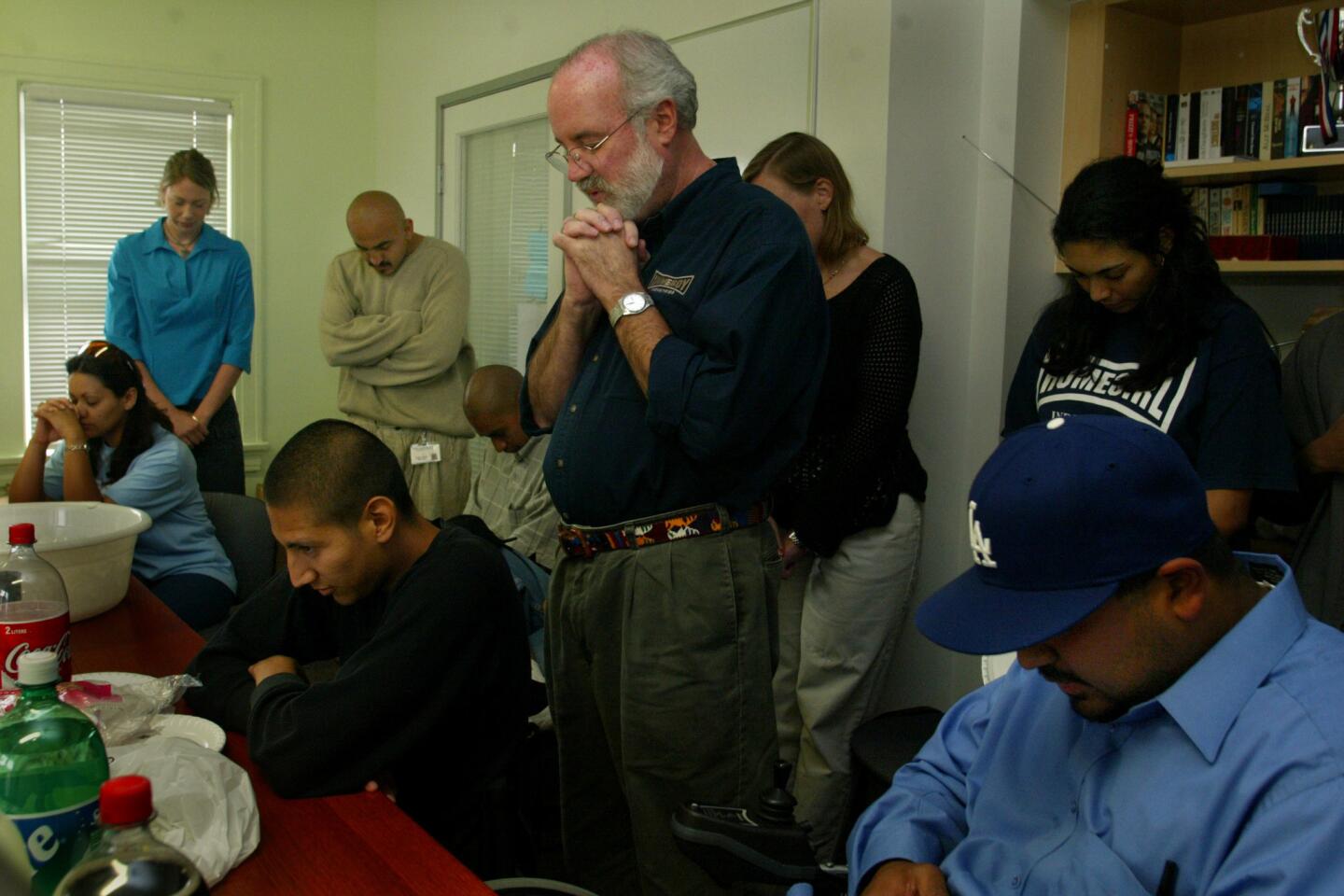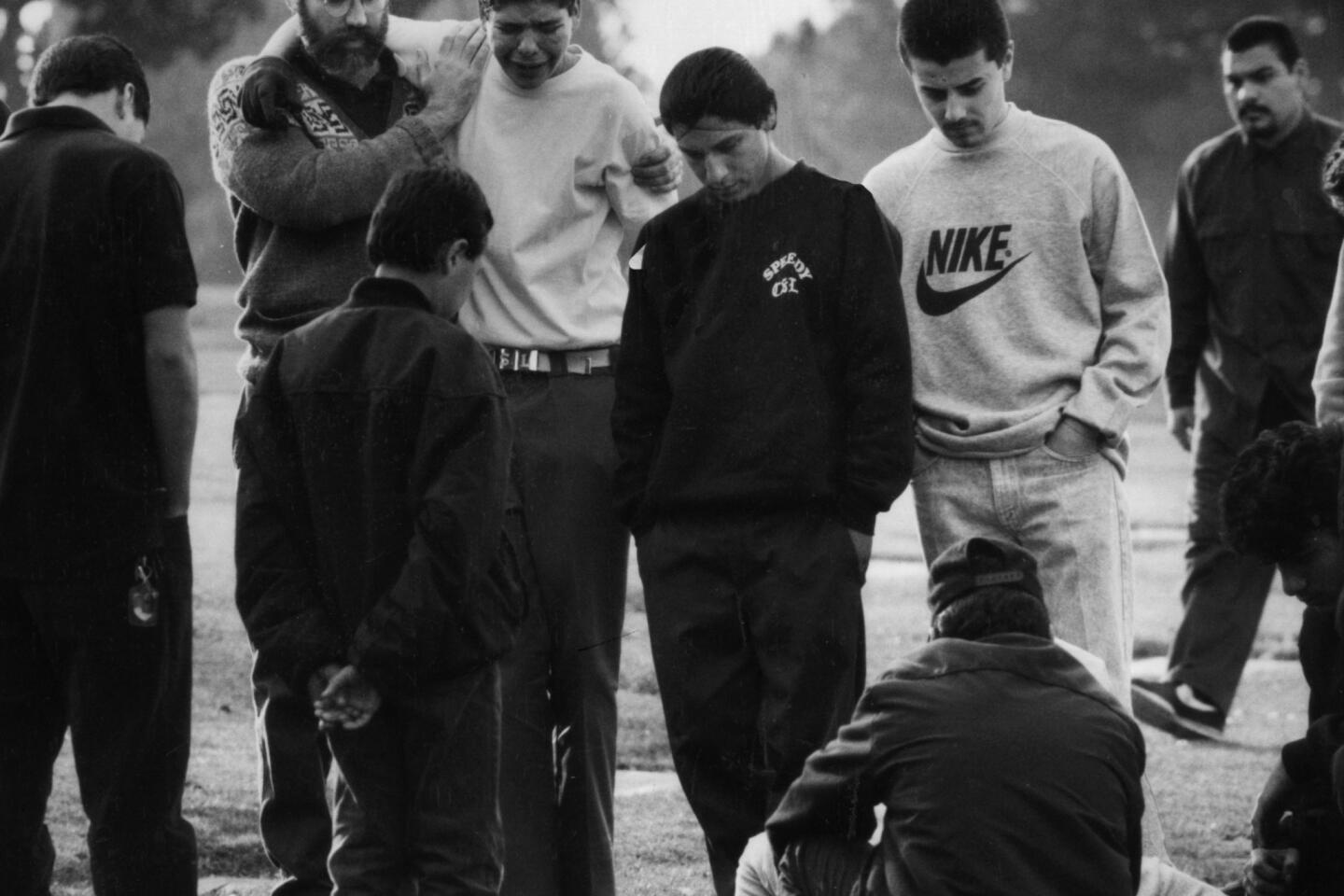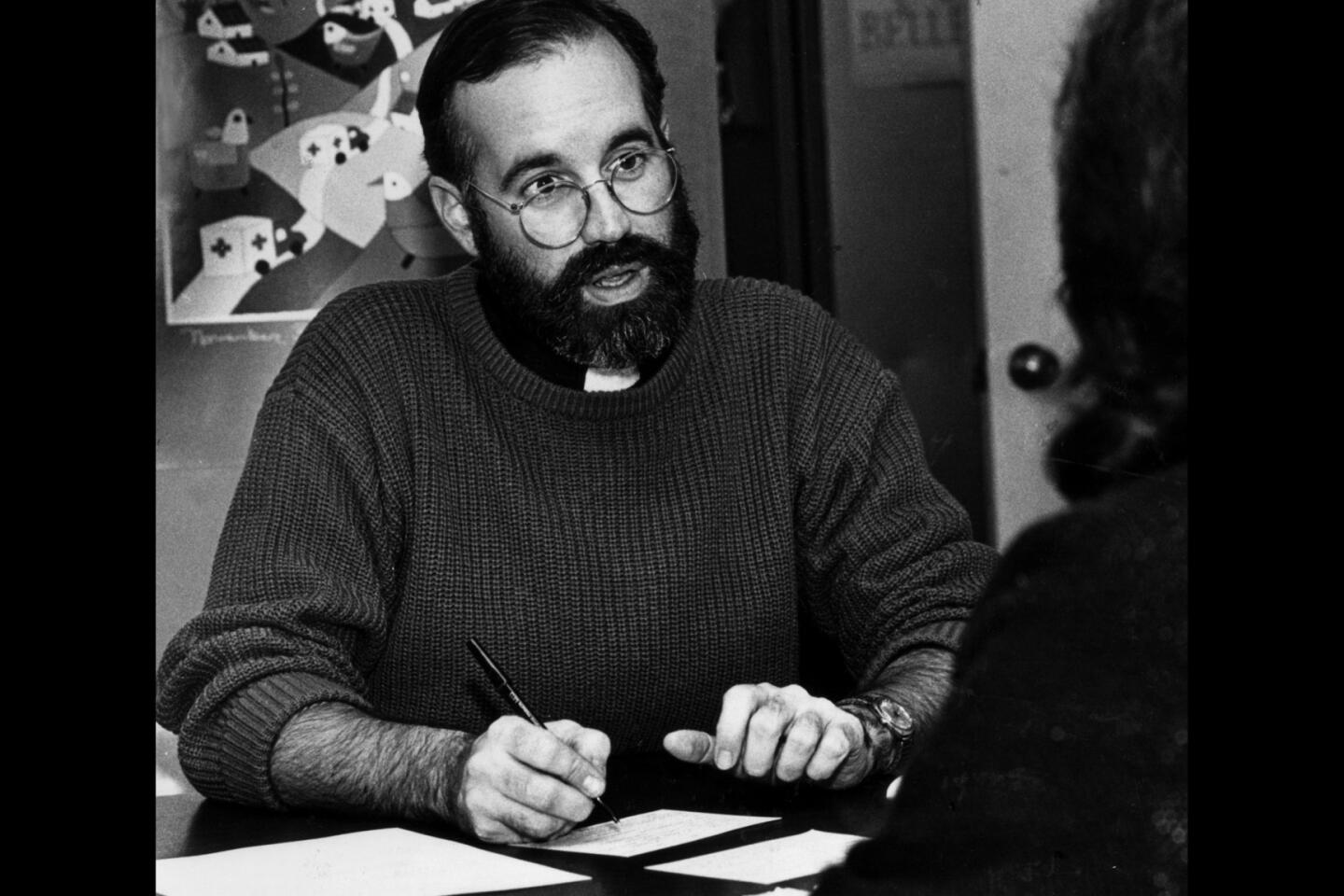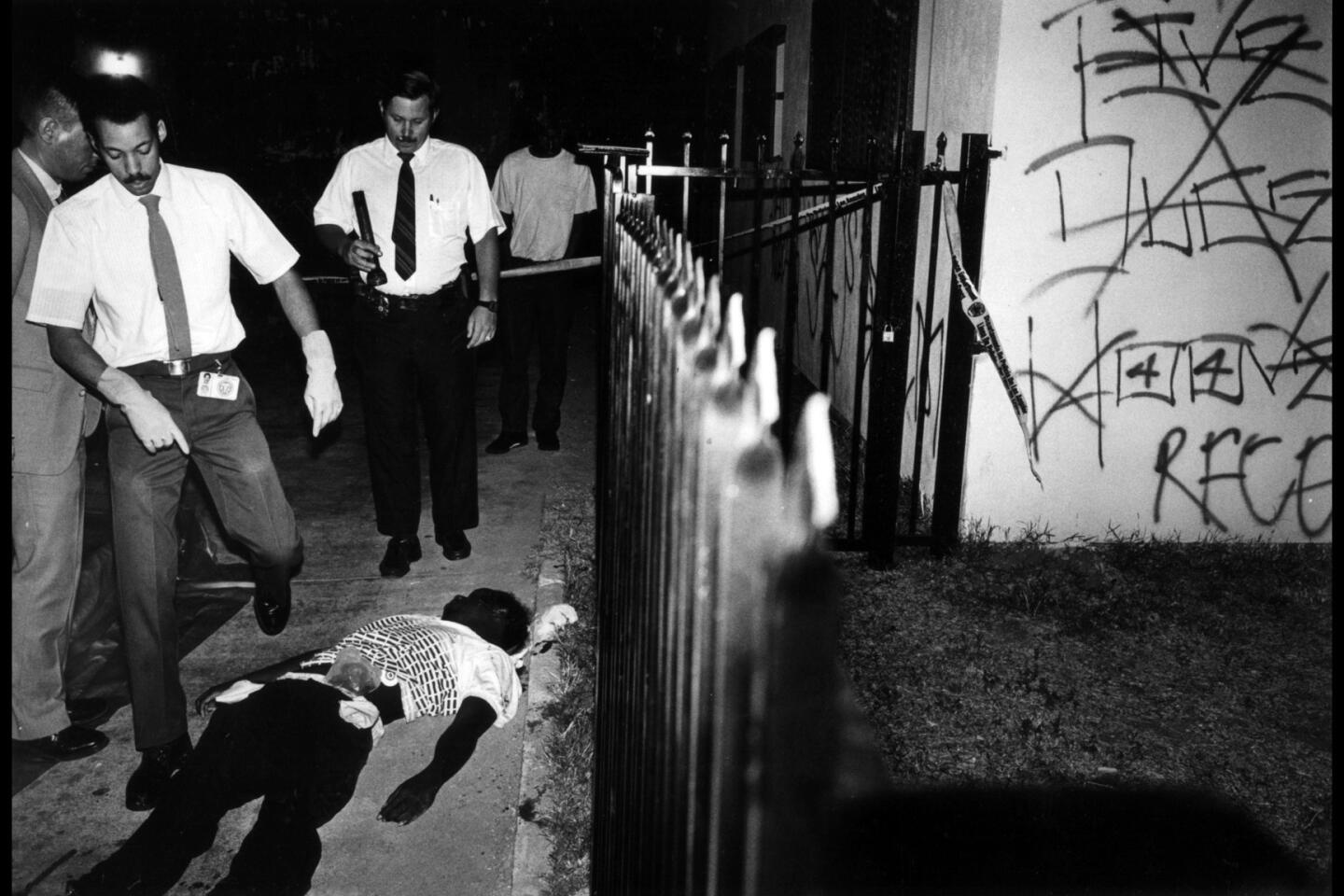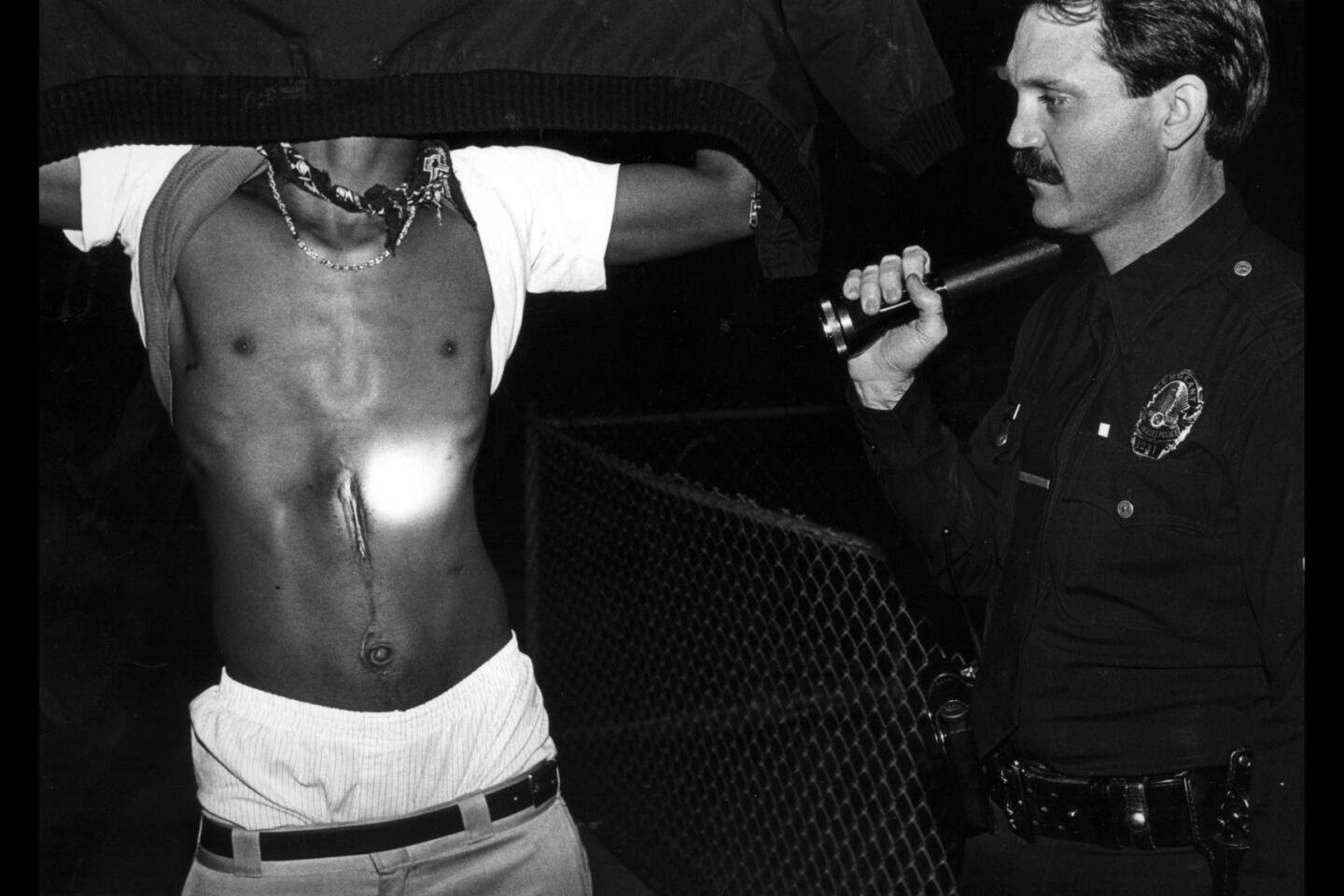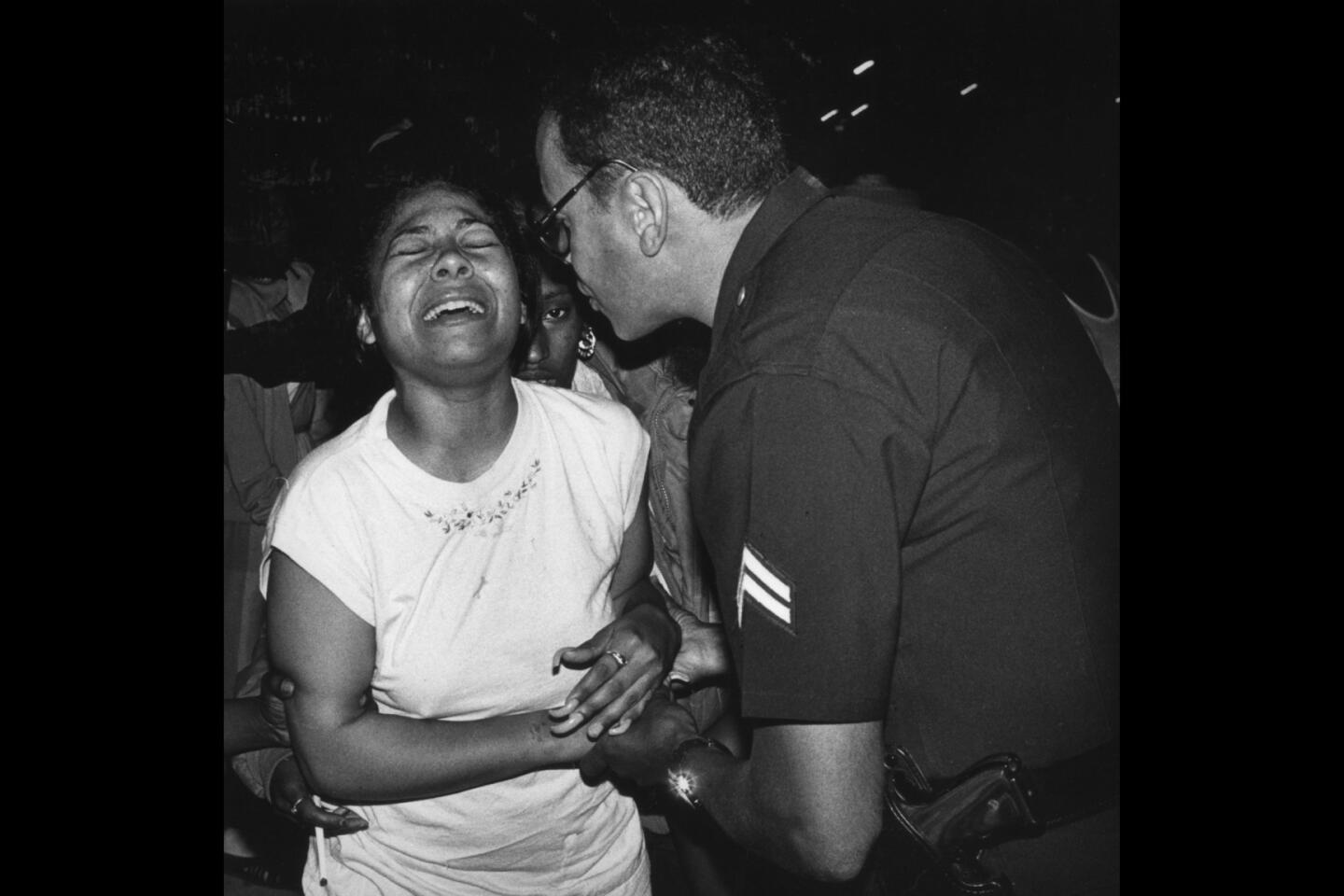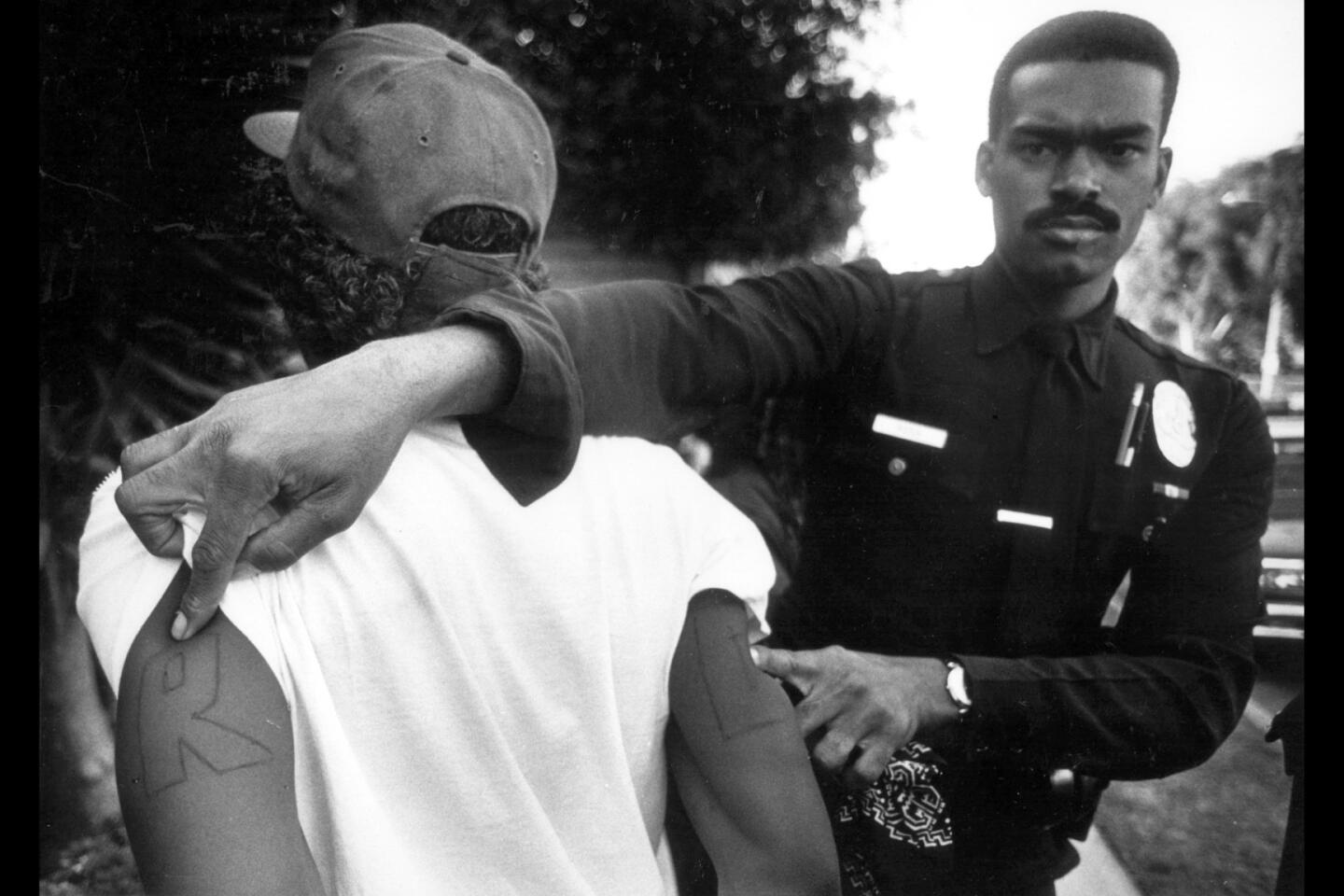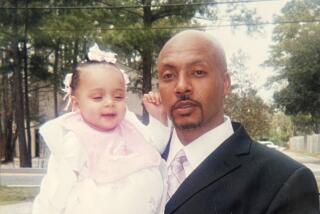Great Read: After 30 years of helping gang members, Father Greg Boyle is slowing a bit but still determined
In a small mortuary in East Los Angeles, a mother wept over the silver casket holding her son. Behind the pews, photos of Roger Soriano showed a young man throwing up gang signs with friends, a tattoo reading “J13” for Jardin 13 etched into his scalp.
He had been killed at 21, shot dead as he allegedly tried to rob a shopkeeper.
Behind the pulpit on that July day, the priest betrayed no strain in conjuring up virtues from the short arc of a life that had ended so messily.
“I knew Roger when he was a little kid and later on when he was a teenager, and you could always see the goodness. Always,” Father Greg Boyle said. “Where Roger is right now, he has the same perspective that God has. The same God that is too busy loving us to be disappointed.”
For decades now, young men who died by the gun have gotten their final benediction from Boyle, who began as a fresh-faced, thirtysomething priest in an era when the City of Angels churned out gang carnage on an industrial scale, inspiring movies such as “Boyz n the Hood” and “Colors” and making “drive-by” part of the country’s lexicon.

For the last 30 years, Father Gregory Boyle and Homeboy Industries have been supporting and training formerly incarcerated and gang-involved individuals in East L.A. Former gang members reveal their process of healing.
In some years in the early 1990s, more than 2,000 people were killed in L.A. County. The deaths came hard and fast. During one three-week period, Boyle buried eight young men and boys.
Boyle is now 61. His hair has thinned and turned white. Soriano’s funeral was his 200th connected to the gang lifestyle. But he had gone months without one.
“I couldn’t go through all that again,” Boyle said. “It was too intense, but you do it. It was like war.”
::
Few people can lay claim to witnessing the evolution of violence in L.A. like Boyle, a Jesuit who in 1988 created Jobs for a Future at the Dolores Mission parish in Boyle Heights. That became Homeboy Industries, a company devoted to helping young men and women transition away from gangs through education, job training and employment.
After the 2008 economic collapse, Homeboy Industries almost went broke. This year, it was named in a federal gang indictment.
But during that time, gang crime, especially homicides, plummeted. Notwithstanding a recent surge in violence, particularly in South L.A., the city is a far less violent place than it once was.
I don’t ever want us to be terrified of tarnishing our reputation or wondering, ‘What if one of our clients turns around and does something awful?’ ... Relapse happens.
— Father Greg Boyle
The Sheriff’s Department estimates that there are about 65,000 gang members in L.A. County. In the mid-90s, the number topped 90,000.
In the beginning, Boyle was consumed by his mission, taking late-night calls after yet another bout of neighborhood mayhem. Today, the priest, who’s been battling leukemia for more than a decade, says he has been able to slow down.
“I’m more balanced about it. My job isn’t to fix or rescue or to save,” he said from his Chinatown office. “It’s to accompany, see people, listen to them.... I think it’s the reason I don’t burn out now. I haven’t been close to burnout since 1992.”
Boyle now winces at the motto that still graces T-shirts throughout Homeboy Industries: “Nothing stops a bullet like a job.”
In those days, especially with SWAT teams cracking down in neighborhoods, he believed what the county really needed was a SWAT team of employers sweeping down Pico Gardens and hiring gang members.
“It’s partly right, because you need a reason to get up in the morning and a reason not to gangbang, and jobs do that,” Boyle said. “But now, after working with gang members for 30 years, I can see that it’s about healing.”
::
Over the years, Boyle has been celebrated as a hero and an L.A. original. But he has also been criticized, often by police officers who insist that he’s naive about gang members and shields them from law enforcement.
LAPD Det. Jose Ramirez, a homicide investigator in the Hollenbeck Division, which includes Boyle Heights, Lincoln Heights and El Sereno, recalls doing foot patrols in the neighborhood in 1991 and seeing Boyle out talking with gang members.
“I think that probably made it very difficult for the officers to work with Greg Boyle,” Ramirez said. “I know a lot of the officers probably weren’t too fond of him. Probably felt like he was on the wrong side. I think it was them not understanding his goals and what he was trying to accomplish.”
Although Ramirez said he never had an issue with Boyle, he recalls investigating a number of crimes in which the officer would stop someone and later find out the person was working for Homeboy Industries.
“We sometimes got that feeling that maybe they were just using him,” Ramirez said. “They’re involved with Homeboy Industries during the day, but at nighttime they were out there still committing crimes.”
In June, a federal indictment of nearly two dozen gang members in L.A.’s northeast neighborhoods named Homeboy Industries, saying several of the defendants used the building to do business. Prosecutors also say a gun exchange took place at Homeboy Industries.
The priest is not named in any of the criminal charges, and there is no investigation against Boyle or Homeboy, said Meredith Davis, a special agent with the Bureau of Alcohol, Tobacco, Firearms and Explosives.
The day won’t ever come when ATF or anybody knows these gang members better than Homeboy Industries. Never, ever, ever.
— Father Greg Boyle
Boyle said it’s the occasional cost of working with people whom not a lot of others would touch.
“I don’t ever want us to be terrified of tarnishing our reputation or wondering, ‘What if one of our clients turns around and does something awful?’ It’s happened,” Boyle said. “But I don’t think a drug addict relapsing reflects in any way on a good rehab.... Relapse happens, especially when you’re dealing with folks who are frankly the least likely to succeed based on their own pasts and difficulties.
“We can work with the most likely to succeed. I’m not interested in that.”
And he has a few sharp words for the police, likening them to the parking attendant at USC Norris Comprehensive Cancer Center, where he occasionally goes for treatments. The attendant has contact with cancer patients in the same way that police officers have contact with gang members, he said.
Yet you’d never invite the parking attendant to sit on a panel on curing leukemia, he said.
“The idea that any law enforcement agency or person would ever know these gang members better than Homeboy Industries is impossible,” Boyle said. “But we have to put up with their nonsense, ‘Oh, pat pat, condescension, oh Homeboy, they’re so naive. If only they knew gang members like we do.’ Which is preposterous.
“The day won’t ever come when ATF or anybody knows these gang members better than Homeboy Industries. Never, ever, ever.”
::
In the old days, Boyle negotiated truces and peace treaties among warring gangs. He stopped doing that years ago, believing that in many ways it endorsed the cohesion of a gang. He would work with the human being, he decided, not the gang.
Sitting in his office recently, the priest studied a young man seated in front of him, taking in the tattoo on his forehead and bruised eye.
Miguel had just gotten out of prison and was hoping to join Homeboy’s 18-month training program. He’d spent the previous night at a Denny’s, after his mother made him leave her Watts home to keep him away from a gang that had jumped him. He had nowhere else to go, he said.
“What neighborhood are you from?” Boyle asked curtly.
“I don’t gangbang,” Miguel said.
Although skeptical, Boyle told Miguel to come in for a drug test to start the process of joining the program. Miguel was just one of dozens of people, mostly young men and teenage boys, who took a seat in front of Boyle’s desk that Wednesday. They confided in Boyle like they would a priest inside a church confessional. He called each of them “mijo” or “mija,” and gave them a hug. Some he handed cash to help them out.
Occasionally Boyle’s attention would stray past the person before him, past the glass doors, which were kept meticulously clean so he could see what was going on outside. He said the violence from the early days had given him a hyper-vigilance born out of post-traumatic stress disorder.
Recent years have seen a different kind of stress. In 2010, the same year Boyle’s book, “Tattoos on the Heart,” was released, the organization had to lay off 300 people. Because of the recession, foundations pulled back funding.
A lot of people say this is a front for the Mexican Mafia. Maybe if we were ... we wouldn’t have so many financial difficulties.
— Father Greg Boyle on Homeboy Industries
“We started to unravel,” Boyle said. “It’s that kind of desperate moment where you go, ‘OK, we don’t have enough money to do this’ … and then we’d bring them in anyway … hoping against hope that somebody would wave a magic wand.”
Today, the organization has had to bring in fewer people, and it barely manages to raise the $10 million a year needed, Boyle said.
“A lot of people say this is a front for the Mexican Mafia,” he said. “Maybe if we were ... we wouldn’t have so many financial difficulties.”
Boyle has had to slow down too. Homeboy employees have taken over more of the daily responsibilities, sometimes sitting in his office, where a “Chillin’ with my homies” sign hangs among dozens of photos of people who have come through his life.
“It’s not so much that the place runs without me. The place’s heart beats without me,” Boyle said. “And that’s good, because how do I break this to them? I’m not going to be here forever. I don’t plan on going anywhere, but I don’t know anybody for whom death is an exception.”
Twitter: @brittny_mejia
MORE GREAT READS
A classic car mystery: Who owns the real ‘million-franc’ Delahaye?
Russia’s military clubs for teens: Proud patriotism or echoes of fascism?
Tethered by a string and trust, a blind sprinter and his guide make history
More to Read
Start your day right
Sign up for Essential California for news, features and recommendations from the L.A. Times and beyond in your inbox six days a week.
You may occasionally receive promotional content from the Los Angeles Times.



